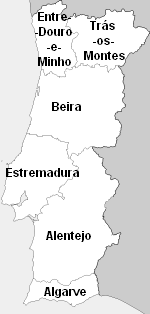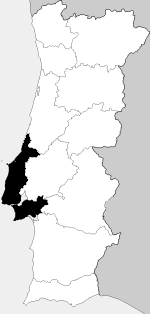
Administratively, Portugal is de jure unitary and decentralized state. Nonetheless, operationally, it is a highly centralized system with administrative divisions organized into three tiers. The State is organized under the principles of subsidiarity, local government autonomy, and democratic decentralization of the public service.

The District of Leiria is a district located in Centro region of Portugal, divided between the traditional provinces of Beira Litoral and Estremadura. It borders on the north with district of Coimbra, on the east with district of Castelo Branco and with district of Santarém, on the south with district of Lisbon and on the west with the ocean Atlantic. The district capital is the city of Leiria.

The Lisbon Metropolitan Area is a metropolitan area in Portugal centered on Lisbon, the capital and largest city of the country. The metropolitan area, covering 18 municipalities is the largest urban area in the country and the 10th largest in the European Union, with a population in 2015 of 2,812,678 in an area of 3,015.24 km².

The Ribatejo is the most central of the traditional provinces of Portugal, with no coastline or border with Spain. The region is crossed by the Tagus River. The region contains some of the nation's richest agricultural land, and it produces most of the animals used in the Portuguese style of bullfighting.

Beira was one of the six traditional provinces or comarcas of Portugal.

The Centro Region or Central Portugal is one of the statistical regions of Portugal. The cities with major administrative status inside this region are Coimbra, Aveiro, Viseu, Caldas da Rainha, Leiria, Castelo Branco, Covilhã, Torres Vedras and Guarda. It is one of the seven Regions of Portugal. It is also one of the regions of Europe, as given by the European Union for statistical and geographical purposes. Its area totals 28,462 km2 (10,989 sq mi). As of 2011, its population totalled 2,327,026 inhabitants, with a population density of 82 inhabitants per square kilometre.

Grande Lisboa is a former Portuguese NUTS III subregion integrated in the Lisboa Region. It was abolished at the January 2015 NUTS 3 revision. It is part of the historical Estremadura Province. It includes the capital and prime city of Portugal, Lisbon. It is the main economical subregion of the country. It covers 1,376 km2 and it is the most populous and most densely populated Portuguese subregion.
Rodoviária Nacional was the state-owned bus network in Portugal, resulting from the nationalization, in 1975, of the largest bus operators in the country, basically the criteria used for nationalization was the fleet size : more than 60 vehicles.
Cartaxo is a Portuguese wine region centered on the town of Cartaxo and overlapping the Estremadura and Ribatejo VR regions. The region was initially a separate Indicação de Proveniencia Regulamentada (IPR) region, but in 2003, it became one of six subregions of the Ribatejo DOC, which has the higher Denominação de Origem Controlada (DOC) status. Its name may still be indicated together with that of Ribatejo, as Ribatejo-Cartaxo.
Cova da Beira is a Portuguese wine region centered on the Cova da Beira region between the Dão and Vinho Verde DOCs in the wider Beiras VR wine region. Cova da Beira was initially a separate Indicação de Proveniencia Regulamentada (IPR) region, but in 2005, it became one of three subregions of the Beira Interior DOC, which has the higher Denominação de Origem Controlada (DOC) status. Its name may still be indicated together with that of Beira Interior, as Beira Interior-Cova da Beira.

Encostas d'Aire is a Portuguese wine region located on the limestone hills extending across the northern end of the wider Lisboa wine region into the southwestern corner of the Beiras region. The region was initially an Indicação de Proveniencia Regulamentada (IPR) region, but in 2005, it was elevated to Denominação de Origem Controlada (DOC) status, and at the same time the Alcobaça IPR was merged into Encostas d'Aire to form a subregion.

Carcavelos is a Portuguese wine region centered on the Carcavelos municipality in Estremadura region and includes land near the cities of Cascais and Oeiras. The region has Portugal's highest wine classification as a Denominação de Origem Controlada (DOC). Located at the very southern tip of the Estremadura region, the region has a long winemaking history dating back to the 18th century when Sebastião José de Carvalho e Melo, Marquis of Pombal owned vineyards here. The region is known for its fortified wine production, creating off dry, topaz colored wines that have nutty aromas and flavors. While once a thriving wine region, world-renowned in the 19th century for its tawny colored fortified wine, in the modern era Carcavelos has been devastated by real estate development in the suburbs of the capital city of Lisbon and nearby coastal city of Estoril.

Beiras is a Portuguese wine region covering the same areas as its namesake region. The region is classified as a Vinho Regional (VR), a designation similar to a French vin de pays region. Located in the northern regions of Portugal, Beiras produces wines of every imaginable style including sparkling and fortified wines but quality varies dramatically depending on producer and region.

Tejo, until 2009 named Ribatejo, is a Portuguese wine region covering the same areas as the Ribatejo Province. It takes its name from the river Tejo (Tagus). The entire region is entitled to use the Vinho Regional designation Tejo VR, while some areas are also classified at the higher Denominação de Origem Controlada (DOC) level under the designation DoTejo DOC. VR is similar to the French vin de pays and DOC to the French AOC.
The Portuguese postal code is formed by four digits, a hyphen, then three digits, followed by a postal location of up to 25 characters in capitals.
Avenida Marconi 4C 1000-260 Lisboa

The term "provinces" has been used throughout history to identify regions of continental Portugal. Current legal subdivisions of Portugal do not coincide with the provinces, but several provinces, in their 19th- and 20th-century versions, still correspond to culturally relevant, strongly self-identifying categories. They include:
Beira Interior is a Portuguese wine Denominação de Origem Controlada (DOC) located in central Portugal in the Beiras VR wine region. It was created in 2005 when three Indicação de Proveniencia Regulamentada (IPR) regions were put together into one DOC.

Estremadura Province is a historical province of Portugal. It is located along the Atlantic Ocean coast in the center of the country and includes Lisbon, the capital. Other notable places include Almada, Amadora, Barreiro, Caparica, Peniche, Cabo da Roca, Caldas da Rainha, Alcobaça, Nazaré, Lourinhã, Torres Vedras, Montijo, and Setúbal.

Estremadura Province is one of the six historical provinces of Portugal. It is located along the Atlantic Ocean coast in the center of the country and includes Lisbon, the capital. The name of this province originates from the Spanish and Portuguese struggle with the Moors, and the Christian reclaiming of their land in the 12th century. These provinces were called Extrema Durii, which means "farthest from the Douro River."












